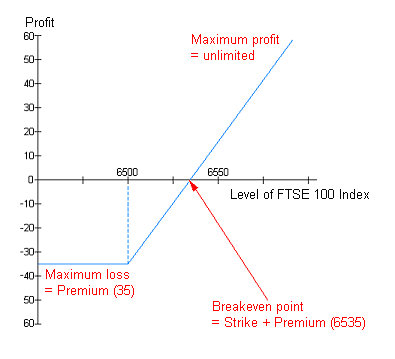Buying a Call
This is strategy that you would employ if you were bullish about the prospects of the underlying asset.
Consider someone buying the December FTSE® 6500 Call. Let’s say that the Option has a premium of 35. As mentioned before, the expiry date of this Option is the third Friday in December.
The holder of the Option has the right to buy the December FTSE® at 6500 on or before the third Friday in December. Let’s consider now different levels of the index and how they affect the investor’s profit/loss at the point of expiry on the third Friday.
Let’s say the expiry price of the December FTSE® is 6453. The right to buy at 6500 is worth nothing. The underlying is cheaper -- what would be the point in paying anything for the right to buy at a more expensive price? The option was bought at 35 and expires at 0, meaning a 35 point loss. With a spread bet, this would be 35 times the bet size. So, if the client had place £2/point Up Bet at 35 on the Dec FTSE® 6500 Call, he would have lost £70.
If the December FTSE® expires at 6500, the loss is still the same: although the index has reached the strike price of the option, there is still no point in paying anything for the right to buy at the current level of the market. You would only pay for the right to buy the market at a cheaper level than the current price.
If the December FTSE® expires at 6562, say, the 6500 Call would be worth 62 points – the right to buy at 6500 has to be valued at 62 if you know that the you can sell the market at 6562.
We can show graphically the value of this Option for different levels of the index at expiry:

As can be seen from the graph, anywhere below 6500 equates to the maximum loss of 35 points (£70 at £2/point). The position is in profit if the FTSE® expires anywhere higher than 6535. Hence 6535 is the breakeven level: the point at which the Option is worth enough to make back the premium that it originally cost. The breakeven point is calculated by adding the premium to the strike price. In the example this is 35 + 6500 = 6535.
Risk
If you buy a Call Option, the risk is limited to the premium. In the example the premium was only a small fraction of the value of the FTSE®, so buying the Option can be considered to be less risky than buying the FTSE®. You should remember, though, that the whole premium is at risk and it can be easy to lose 100% of the amount you are risking.
Reward
The rewards are potentially unlimited when buying a Call Option. The value of the Call will increase with the value of the underlying asset. In our example, at expiry, the number of points profit will equal the amount by which the level of the FTSE® 100 exceeds the strike price, less the premium of the Call.
Selling a Call